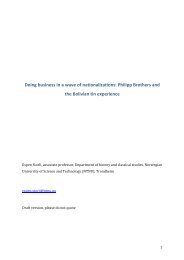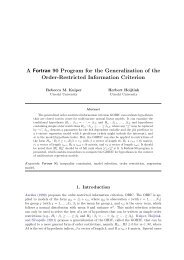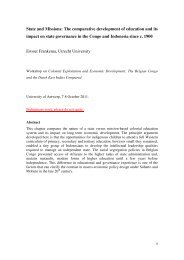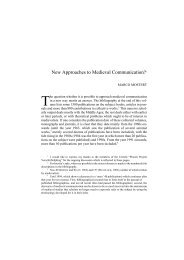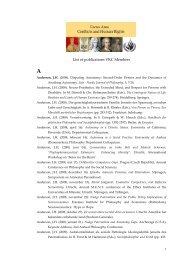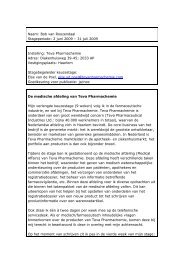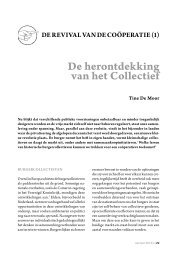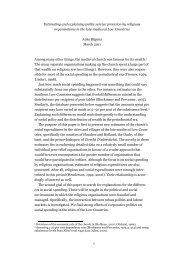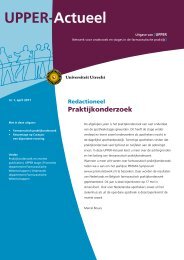Micro-macro multilevel analysis for discrete data
Micro-macro multilevel analysis for discrete data
Micro-macro multilevel analysis for discrete data
Create successful ePaper yourself
Turn your PDF publications into a flip-book with our unique Google optimized e-Paper software.
8 th International AmsterdamConferenceMultilevel AnalysisMarch 17 & 18, 2011Scientific committeeJoop Hox, Mirjam Moerbeek, Rens van de Schoot & Leoniek WijngaardsLocal organisation committeeKevin van Kats & Flip BoerlandUtrecht UniversityDepartment Methodology & StatisticsFinancial support from the Royal Dutch Academy of Arts and Sciences(KNAW) is gratefully acknowledged
MULTILEVEL CONFERENCE PROGRAMMEThursday, March 179:00 Registration9:25 Opening9:30 Keynote presentation: Stephen WestApproaches to Multilevel Repeated Measures Data: Roles <strong>for</strong>Centering10:10 Eleni Sofianopoulou, et. al.Multilevel model with offset: A two stage approach <strong>for</strong> modelingrespiratory prescribing, in Primary Health Care.10:30 Fiona SteeleA <strong>multilevel</strong> simultaneous equations model <strong>for</strong> within-cluster dynamiceffects, with an application to reciprocal relationships betweenmaternal depression and child behaviour10:50 BREAKPARALLEL SESSION I-a11:10 Omar Paccagnella, et. al.Profiling financial asset holders across Europe11:30 Adi Pierewan, et. al.Multivariate <strong>multilevel</strong> model of happiness and health across Europeduring crisis11:50 Paul ClarkeThe choice between fixed and random effects <strong>multilevel</strong> models inpolicy-relevant social research12:10 Daniel Caro, et. al.A New Look at the Evaluation of Sociological Theories in InternationalLarge Scale Educational Assessments3
PARALLEL SESSION I-b11:10 Dickson Nkafu Anumendem, et. al.Comparison of Bivariate Multilevel Growth Curve Model and BiparallelProcess Multilevel Latent Growth Model Approaches11:30 Sabine Meinck, et. al.Sampling Precision of Hierarchical Linear Models: Dependence onVarying Sample and Population Conditions11:50 Rok PlatinovšekWhen is the accuracy worth the bother? A simulation-basedcomparison of two multiple imputation procedures applied to clustered<strong>data</strong>sets12:10 Hawjeng Chiou, et. al.Cluster mean replacement in the intercept and slope equations in the<strong>multilevel</strong> modeling: Simulation and empirical study of comparisons ofthe centering methods12:30 LUNCH13:30 Keynote presentation: Bill BrowneStatistical Software at the Centre <strong>for</strong> Multilevel Modelling14:10 George Leckie, et. al.Running MLwiN from within Stata: the runmlwin command14:30 Eva Batistatou, et. al.The per<strong>for</strong>mance of three methods of <strong>analysis</strong> in terms of power <strong>for</strong>trials with a partially nested design14:50 Chris RobertsThe Analysis and Design of Non-Pharmacological Trials withMultiple-Membership due to Therapist15:10 BREAK4
15:30 Neil H. SpencerDetecting a missing level in a <strong>multilevel</strong> model and assessing itsimpact15:50 Adam Steventon, et. al.The use of <strong>multilevel</strong> modelling to minimise likely hidden bias in thedesign of matched control studies16:10 Marianna AvetisyanValidation of the randomized response technique on <strong>multilevel</strong> <strong>data</strong>16:30 END OF THE FIRST DAY5
Friday, March 188:30 START OF THE CONFERENCE WITH COFFEE AND TEA9:00 Benjamin KelceyInferences on Instructional Practice Measured With Multiple Sourcesof Variation9:20 Ehri RyuFactorial invariance in <strong>multilevel</strong> confirmatory factor <strong>analysis</strong>9:40 Steven Teerenstra et. al.A simple sample size <strong>for</strong>mula <strong>for</strong> <strong>analysis</strong> of covariance in clusterrandomized trials10:00 Esther de HoopThe simplest stepped wedge10:20 Gerard van BreukelenEfficient design of cluster randomized and multisite trials withunknown intraclass correlation and varying cluster size10:40 BREAKPARALLEL SESSION II-a11:00 Anna CuxartDesign Effect and Interviewer Effects: evidence from the SpanishESS3-2006 Data11:20 Antonie Knigge, et. al.The total influence of family background on status attainment in theNetherlands from 1842-1922 – a <strong>multilevel</strong> sibling model11:40 George Leckie, et. al.The social relations model <strong>for</strong> dyadic count <strong>data</strong>, with an applicationto inter-household meat sharing in Nicaragua6
PARALLEL SESSION II-b11:00 Victor H. Cervantes, et. al.Estimating item parameters <strong>for</strong> the dichotomous Rasch model with acomplex sampling design11:20 Josine VerhagenA Bayesian Multilevel IRT Model <strong>for</strong> Testing Measurement Invariancein Cross-national and Longitudinal Surveys11:40 Margot Bennink, et. al.<strong>Micro</strong>-<strong>macro</strong> <strong>multilevel</strong> <strong>analysis</strong> <strong>for</strong> <strong>discrete</strong> <strong>data</strong>12:00 LUNCH13:00 Keynote presentation: Douglas BatesAssessing precision of estimates through sensitivity <strong>analysis</strong>13:40 Elly Korendijk, et. al.Sample size requirements when applying a Fishbein-Ajzen Model incluster randomized trials. A simulation study.14:00 Mark de RooijThe clustered trend vector model14:20 Ian PlewisPredicting Missingness in Longitudinal Studies: Can the SampleDesign Help?14:40 BREAK15:00 Tobias Koch, et. al.Structural Equation Models <strong>for</strong> Multitrait-Multimethod-Multioccasion(MTMM-MO) Data Combining Structurally Different andInterchangeable Methods15:20 Martin Schultze, et. al.Modeling longitudinal MTMM <strong>data</strong> with interchangeable andstructurally different methods: An application to developmentalpsychology.15:40 Elif Ünal Çoker, et. al.Exploring the Per<strong>for</strong>mance of In<strong>for</strong>mation Criteria in MultilevelStructural Equation Modelling16:00 THE END OF THE MULTILEVEL CONFERENCE 20117
Comparison of Bivariate Multilevel Growth Curve Modeland Bi-parallel Process Multilevel Latent Growth ModelApproaches.Anumendem, Dickson Nkafu, Bieke De Fraine,Patrick Onghena and Jan Van DammeThere is an increasing interest in the field of educational effectiveness research <strong>for</strong>studying changes in pupils’ outcomes. However, most studies focus on the growth inonly one effectiveness criterion, which is problematic given that school effects areonly moderately consistent over different criteria. Multiple criteria have seldom beenstudied through multivariate growth curve models. The current study investigatesschool effects on pupils’ growth in mathematics and reading comprehension inprimary schools through the use of the two contemporary and competing frameworks<strong>for</strong> the <strong>analysis</strong> of growth curve model. The bi-parallel process <strong>multilevel</strong> latentgrowth model which models two dependent outcome variables as multivariatevariable with the repeated measurements of the two variables all becoming variablesin themselves and all assumed independent. This is unlike the bivariate <strong>multilevel</strong>growth curve model which considers independence only <strong>for</strong> the repeatedmeasurements of the same outcome variable but allows the dependence of the twogrowth processes. The later enables a statistical test <strong>for</strong> the need of a multivariategrowth model over separate univariate growth models. Of course constraints can beused in both approaches but then deviations from the fundamental theory behind themare inevitable. By using the proposed two-stage effectiveness criteria, we found someconsistency between school effects criteria. However, the comparison between thetwo approaches reveal that most of the similarities found in univariate repeatedmeasurements growth curves, do not simply export themselves into the multivariaterepeated measurements in terms of their theoretical framework as well as applicationsto real <strong>data</strong>.Keywords: Educational effectiveness, effectiveness criteria, reading comprehension, mathematics, growth curve models,<strong>multilevel</strong> <strong>analysis</strong>, bivariate <strong>multilevel</strong> growth curve model, bi-parallel process <strong>multilevel</strong> latent growth model.Dickson.nkafu@ped.kuleuven.be1 Centre <strong>for</strong> Educational Effectiveness and Evaluation, K.U.Leuven, Belgium2 Centre <strong>for</strong> Methodology in Educational Sciences, K.U.Leuven, Belgium9
Validation of the randomized response technique on<strong>multilevel</strong> <strong>data</strong>Avetisyan, MariannaSurvey respondents usually tend to conceal embarrassing or threatening in<strong>for</strong>mation,particularly when an interviewer might disapprove. This response behavior iscertainly expected in medical settings where the incriminating behavior is negativelyrelated to the recovery from a disease. The lung patient group chosen <strong>for</strong> our researchfeels social (public smoking policy) and professional (pulmonologists) pressureconcerning nonsmoking and there<strong>for</strong>e can experience questions about smokingbehavior as sensitive. For this study a questionnaire measuring attitude towardssmoking was developed. The primary goal of this research was the validation of therandomized response technique, a method of administration of a questionnairestimulating honest responses to sensitive questions. For validation purposes in the firststage of the research the subjects filled in the questionnaire in a conventional way, i.e.by direct questioning, or using the randomized response technique followed by thesecond stage when a breath test using a carbon monoxide (CO) monitor was takenrevealing the actual smoking status of the subject. The observed responses arehierarchical in nature with the three-level hierarchy of measurements nested withinpatients nested within pulmonologists. These hierarchical <strong>data</strong> are analyzed using IRTmeasuring the attitude toward smoking.Key words: randomized response, item response theory, <strong>multilevel</strong> modeling, Bayesian inference.Marianna AvetisyanUniversity of TwenteFaculty of Behavioural SciencesDepartment of Measurement and Data AnalysisP.O. Box 217, 7500 AE Enschede, The Netherlandsm.avetisyan@gw.utwente.nl10
Assessing precision of estimates through sensitivity <strong>analysis</strong>Bates, DouglasFitting a mixed-effects model to observed <strong>data</strong> provides point estimates of theparameters. As part of the statistical <strong>analysis</strong> we should also describe the precision ofthe parameter estimates, say through confidence intervals, and provide methods <strong>for</strong>per<strong>for</strong>ming hypothesis tests. Frequently confidence intervals on coefficients and onvariance-component parameters are constructed as symmetric intervals derived froman approximate standard error and the quantiles of a t or z distribution. There is sometheoretical justfication <strong>for</strong> such intervals on the coefficients of models fit to balanced<strong>data</strong> but the arguments fail in the case of coefficients <strong>for</strong> models fit to unbalanced,observational <strong>data</strong> and in all cases <strong>for</strong> variance-component parameters. Even in thesimplest case of estimating the variance of a normal distribution based on a randomsample we realize that confidence intervals will be highly asymmetric. Expecting thatthe variability in estimates of variance components <strong>for</strong> much more complex modelswill be adequately summarized by a standard error leading to symmetric intervals is,at best, optimistic. We present methods of assessing the variability by profiling thelikelihood, which is a <strong>for</strong>m of "sensitivity <strong>analysis</strong>". That is, we examine thesensitivity of the estimation criterion - the deviance, in this case - to changes inindividual parameters. The deviance profiles allow <strong>for</strong> assessment of the precision ofindividual parameters and <strong>for</strong> projections of contours of the deviance on pairs ofparameters.11
The per<strong>for</strong>mance of three methods of <strong>analysis</strong> in terms ofpower <strong>for</strong> trials with a partially nested designBatistatou, Eva; Roberts, ChrisPartially nested <strong>data</strong>, where <strong>for</strong>ming clusters of individuals <strong>for</strong> the purpose of theclinical trial in pthe experimental condition only, arise in trials of group administeredtreatments. It is well known that application of conventional sample size estimation<strong>for</strong>mulae which do not account <strong>for</strong> the cluster size and the intraclass correlationcoefficient (ICC) within experimental condition may lead to sample size estimatesthat are too small and trials that are inadequately powered. Additionally, the outcomevariance in the two trial arms may not be equal, leading often to substantialheteroscedasticity between arms. Calculating power by integrating the noncentral F-distribution1 – implemented in our clsampsi Stata’s program2 – may be moreappropriate. Here we report results from a simulation study <strong>for</strong> partially nestedcontinuous <strong>data</strong> that evaluated the per<strong>for</strong>mance of three <strong>analysis</strong> approaches in termsof empirical power: the partially nested model via REML and ML estimation methodsand the unequal variance t-test applied to a cluster-level summary; various numbersof clusters, cluster sizes, ICCs <strong>for</strong> the intervention arm and trial arm variance ratioswere used. The empirical power calculated via simulations was compared with thatcalculated through our clsampsi program. It was shown that using the t-test <strong>for</strong>analyzing partially nested <strong>data</strong> attains empirical power very close to that calculated byclsampsi <strong>for</strong> all the parameter scenarios tested, while the other two approaches of<strong>analysis</strong> give either larger or considerably larger empirical power <strong>for</strong> almost all thescenarios.1 Roberts & Roberts (2005).2 http://www.medicine.manchester.ac.uk/healthmethodology/research/biostatistics/<strong>data</strong>/clsampsi/Key words: partially nested <strong>data</strong>, <strong>multilevel</strong> models, group therapyDr Eva Batistatou - Research Associate - Health Sciences Research Group School of Community Based Medicine - University ofManchester, UK - E.Batistatou@manchester.ac.ukDr Chris Roberts - Reader in Biostatistics - Health Sciences Research Group School of Community Based Medicine - Universityof Manchester, UK – Chris.Roberts@manchester.ac.uk12
<strong>Micro</strong>-<strong>macro</strong> <strong>multilevel</strong> <strong>analysis</strong> <strong>for</strong> <strong>discrete</strong> <strong>data</strong>Bennink, Margot; Croon, Marcel A.; Vermunt, Jeroen K.This study deals with models <strong>for</strong> predicting outcomes at the higher level (e.g. teamper<strong>for</strong>mance) from explanatory variables at the lower level (e.g. employee’smotivation and skills). This “reversed” <strong>multilevel</strong> <strong>analysis</strong> problem is rather commonin social sciences, and is sometimes referred to as micro-<strong>macro</strong> <strong>analysis</strong>. Recently,Croon and Van Veldhoven proposed a statistical model <strong>for</strong> micro-<strong>macro</strong> <strong>multilevel</strong><strong>analysis</strong> which involves using a factor analytic structure in which the scores of thelower-level units are seen as indicators of latent factors at the group level. The key isthat the outcome variable is not regressed on the aggregated group mean(s) of themicro-level predictor(s) but on the latent <strong>macro</strong>-level variable(s). The aim of theproject, from which the current study is a part, is to generalize this approach so that itcan also be applied when the explanatory and/or outcome variables are <strong>discrete</strong>instead of continuous and normally distributed. Two new models <strong>for</strong> micro-<strong>macro</strong>relations between <strong>discrete</strong> variables are presented; a simple 1-2 model in which adichotomous micro-level variable affects a dichotomous <strong>macro</strong>-level outcomevariable, and a more complex 2-1-2 model in which a dichotomous <strong>macro</strong>-levelvariable has a direct effect on a dichotomous <strong>macro</strong>-level outcome variable and anindirect effect on the outcome through a dichotomous mediating variable defined atthe micro-level. In both models the latent variable at the group level is defined to be<strong>discrete</strong> (latent classes). We present the theoretical background of the models, asimulation study in which their per<strong>for</strong>mance is evaluated, as well as an empiricalapplication.Key words: <strong>multilevel</strong> <strong>analysis</strong>, micro-<strong>macro</strong> relationships, dichotomous outcome variables, <strong>discrete</strong> <strong>data</strong>Margot Bennink Tilburg University Room P1121Phone: +31 13 466 8046 Faculty of Social and Behavioural Sciences PO Box 90153Secretary: +31 13 466 2544 Department Methodology and Statistics 5000 LE Tilburgm.bennink@uvt.nl13
Efficient design of cluster randomized and multisite trialswith unknown intraclass correlation and varying cluster sizeBreukelen, Gerard vanObjective:Optimal sample size equations <strong>for</strong> cluster randomized trials (how many clusters, howmany persons) assume equal cluster sizes and a known intraclass correlation (ICC). Asimple and accurate adjustment <strong>for</strong> varying cluster sizes will be demonstrated. Theassumption of a known ICC is problematic since optimal design depends on this ICCand is thus a locally optimal design (LOD). We present and compare simple solutionsto this problem.Method:A closed <strong>for</strong>m is presented <strong>for</strong> the Maximin design (MMD) given an unknown ICCwith user-specified range [a, b], <strong>for</strong> instance a = 0.01 and b = 0.10. The MMDmaximizes the minimum relative efficiency compared with the LOD, where theminimum is taken over the whole ICC range and corresponding set of LODs. TheMMD is compared with some simple alternatives, such as the LOD <strong>for</strong> ICC = b(called LOD(b)), with respect to sample sizes and per<strong>for</strong>mance.Result:The minimum relative efficiency of the MMD decreases as the ICC range increases,but is always much higher than <strong>for</strong> the LOD(b), while the latter has a higherminimum efficiency. A simple alternative in-between MMD and LOD(b) per<strong>for</strong>msfairly well, whereas the LOD(a) per<strong>for</strong>ms badly, on efficiency and relative efficiency.Conclusion:Maximin design improves robustness against misspecified ICC at the price of someloss of efficiency compared with the LOD <strong>for</strong> the correct but unknown ICC. Bychoosing an ICC range, MMD allows balancing between efficiency and robustness.Keywords: cluster randomized trials, optimal design, Maximin design, intraclass correlation, relative efficiencyAddress:Gerard van Breukelen, Dept. Methodology & Statistics, Faculty of Psychology & Neuroscience, and Caphri School <strong>for</strong> PublicHealth and PrimaryCcare of the Faculty of Health, Medicine and Life Sciences, Maastricht University, p.o. box 616, 6200 MDMaastricht, The Netherlands14
Statistical Software at the Centre <strong>for</strong> Multilevel ModellingBrowne, BillIn this talk, a general history of developments in statistical software at the Centre <strong>for</strong>Multilevel Modelling, first at the IOE in London and then continued in Bristol will begiven. We will discuss developments that lead to the MLwiN package and otherprojects like the MLPowSim and REALCOM packages. We will then describe ourambitious new ESRC funded E-STAT project which builds on initial concepts fromJon Rasbash and is a collaboration with academics from Southampton and severalother UK universities. We will describe how the project aims to inter-operate withother software packages and demonstrate the current incarnation of the software.15
A New Look at the Evaluation of Sociological Theories inInternational Large Scale Educational AssessmentsCaro, Daniel*Sandoval-Hernandez, Andres*The paper uses a mixed approach of theory generating and theory testing to evaluatetheoretical models of cultural and social capital of Bourdieu, Bernstein and Coleman.The <strong>data</strong> stem from two large scale international assessments: PIRLS 2006 and PISA2009. In line with the mixed approach employed, the method is a combination ofexploratory factor <strong>analysis</strong> (EFA) and structural equation models (SEM) known asexploratory structural equation modeling (ESEM). The main advantage of using thismethod is that an EFA measurement model with rotations can be used in a SEM,instead of a confirmatory factor <strong>analysis</strong> (CFA) measurement model. When using theEFA we have the advantage of being able to relax the zero loading restriction,allowing variables to load on different factors simultaneously. The SEM then providesmodel fit indices, yields measurement invariance tests across countries, and correctsfactor scores <strong>for</strong> measurement error. The results provide statistical criteria to evaluatethe fit of theories with the empirical <strong>data</strong> (i.e., more reliably and validly). The papercontributes to the discussion on the advantages and disadvantages of using thesemethods when evaluating sociological theories in the context of international largescale assessments.Keywords: exploratory structural equation modeling, cultural capital, cross-cultural validity, PIRLS* International Association <strong>for</strong> the Evaluation of Educational Achievement (IEA), Data Processing and Research Center (DPC),Hamburg, Germany.16
Cluster mean replacement in the intercept and slopeequations in the <strong>multilevel</strong> modeling: Simulation andempirical study of comparisons of the centering methodsChiou, Hawjeng ; Lin, Pi-Fang,In <strong>multilevel</strong> linear modeling (MLM), the issue of centering Level-1 predictorvariables is critical. In literature, it has been argued that both of centering methods,centering at the grand mean (CGM) and centering within cluster (CWC) hasadvantages and disadvantages. In short, CWC is preferable if the effect of Level 1predictor of X alone on a Y as outcome, and if the cross-level interactions and level-1interactions are of substantive interest. As a result, the cluster mean of X should bereplaced back into the level-2 as a main effect in the intercept equation ( 0j ) becauseCWC removes all between-cluster variation in X. However, the present paper arguedthat the replacement of cluster mean in intercept equation is insufficient. Because itmay exist a significant cross-level interactions of X and cluster mean of X, which canonly be detected by an interaction term of X and cluster mean of X. In other words,replacement of cluster mean of X into the slope equation ( 1j ) along with interceptequation has to be created <strong>for</strong> sufficiently examining the effect of CWC.In order to compare with preview study, we used the artificial <strong>data</strong> set with 300clusters of 40 cases each created by Enders and Tofighi (2007) as a <strong>data</strong>set 1. Resultsof a mixed model using <strong>data</strong>set 1 were comparing with <strong>data</strong>set 2 in which a specialtreatment is made <strong>for</strong> creating a strong interaction term of X and cluster mean of X.Results revealed that, in <strong>data</strong>set 1, there was only main effect of the cluster mean of Xon Y. No significant interaction effect of the X and the cluster mean of X in <strong>data</strong>set 1was reported due to the small effect. In <strong>data</strong>set 2, an artificial interaction between Xand the cluster mean of X was created and, as a result, the interaction term wassignificant. That is, the replacement of the cluster mean into the slop equation isnecessary to detect the effect of interaction of deviation score and its own mean.Besides of the evidences of simulation <strong>data</strong> <strong>analysis</strong>, an empirical <strong>data</strong> selected fromauthor’s previous study consisted of 664 employees sampled from 24 differentorganizations were applied. Results revealed that the CWC with replacement of thecluster mean into the intercept and slope equation at <strong>macro</strong>-level was the bestestimates of fixed effects as well as random effects. Implications and limitations ofthe study were discussed in the final section.Key words: group-mean centering, grand-mean centering, cross-level interaction, replacement of the cluster meanAuthor in<strong>for</strong>mation:Hawjeng Chiou, Ph.D.Associate professorCollege of ManagementNational Taiwan Normal University, TaiwanEmail: hawjeng@ntnu.edu.twPi-Fang Lin, Doctoral candidateGraduate School of EducationNational Cheng Chi University, TaiwanEmail: 95152518@nccu.edu.tw18
The choice between fixed and random effects <strong>multilevel</strong>models in policy-relevant social researchClarke, PaulThe use of fixed and random effects <strong>multilevel</strong> models is discussed in the context ofpolicy-relevant social research, and the assumptions behind the two approaches setout. By explicating the key issues we hope to resolve some of the confusionsurrounding the differences between fixed and random effects <strong>multilevel</strong> models. Toillustrate these issues, an example from education - analysing the determinants ofpupil achievement in primary school - is used. It is concluded that a fixed effectsapproach will be preferable in scenarios where the primary interest is in policyrelevantinferences about the effects of individual characteristics, and the processthrough which individuals are selected into clusters (in this case schools) is eitherpoorly understood or the <strong>data</strong> too limited to adjust <strong>for</strong> selection effects. In thiscontext, the robustness of the fixed effects approach to the random effects assumptionis attractive, and researchers should consider using it if only to assess the sensitivity ofthe random effects estimates to assumption failures. On the other hand, when theselection mechanism is better understood and the researcher has access to rich <strong>data</strong>, arandom effects approach is more natural because it can be used to produce policyrelevantestimates while allowing a wider range of research questions to be addressed;moreover, random effects estimators of regression coefficients and shrinkageestimators of cluster effects are more efficient than those <strong>for</strong> fixed effects.Key words: Causal inference; Confounding bias; Fixed effects; Random effects; Random effects assumption; RobustnessPresenting author: Paul Clarke, Centre <strong>for</strong> Market & Public Organisation, University of Bristol, UKCo-authors: Clarie Craw<strong>for</strong>d, Institute <strong>for</strong> Fiscal Studies, UK; Fiona Steele, University of Bristol, UK; Anna Vignoles, Instituteof Education, University of London, UK.19
Design Effect and Interviewer Effects: Evidence from theSpanish ESS3-2006 DataCuxart, AnnaIn 2007 the first Quality Enhancement Meeting on sampling in the European SocialSurvey (ESS) took place. The discussion focused on design effects and inteviewereffects in face-to-face interviews. Following the recomendations of this meeting theSpanish ESS team studied the impact of interviewers as a new element in the designeffect in the response’s variance using the in<strong>for</strong>mation of the correspondent SampleDesign Data Files. Hierarchical <strong>multilevel</strong> and cross-classified <strong>multilevel</strong> <strong>analysis</strong> areconducted in order to estimate the amount of responses’ variation due to PSU and tointerviewers <strong>for</strong> different questions in the survey. Factor such as the age of theinterviewer, gender, workload, training and experience and respondent characteristicssuch as age, gender, renuance to participate and their possible interactions are alsoincluded in the <strong>analysis</strong> of some specific questions like “trust in politicians” and “trustin legal system”. Some recomendations related to future sampling designs and thecontents of the briefing sessions are derived from this initial research.Key words: interviewer effects, <strong>multilevel</strong> <strong>analysis</strong>, design effect, European social surveyAddresses, sites etc.anna.cuxart@upf.eduUniversitat Pompeu Fabra,Economica and Business department,Campus de la Ciutadella,Ramon Trias Fargas 25,08005 Barcelona,Spain20
The simplest stepped wedgeHoop, Esther deCluster randomized trials are known to be less efficient than individually randomizedtrials, especially if only the outcomes at the end of the study are analyzed (posttestdesign). Using covariates or repeated measurements can improve the efficiency. Inpractice, this is feasible, because often a baseline measurement of the outcome isavailable or easy to obtain, as well as an additional follow-up score.We compare three designs that use repeated measurements or covariates with theposttest design: an ancova model with baseline measurement as covariate, anextension of this ancova model with a follow-up measurement, and a simple steppedwedge model.To compare the efficiency of these designs, we derived variance inflation factors <strong>for</strong>the three extended models in terms of r, which is the correlation of the cluster meansbetween baseline and follow-up.The variance of an ancova <strong>analysis</strong> is a factor r 2 smaller than of an <strong>analysis</strong> on followupscores only. A stepped wedge design results in a small gain in efficiency comparedto the ancova model. The ancova model with an additional follow-up measurement ismuch more efficient than all other methods. As the correlation increases, all modelswith more than one measurement become more and more efficient. Since in manycases correlation between baseline and follow-up is expected, it is worthwhile toconsider research designs with additional measurements.Key words: cluster randomized trials, efficiency, repeated measurements, ancova, stepped wedgeRadboud University Nijmegen Medical CentreDepartment of Epidemiology, Biostatistics and HTA 133PO Box 91016500 HB NijmegenThe NetherlandsE-mail: E.deHoop@ebh.umcn.nl21
Inferences on Instructional Practice Measured WithMultiple Sources of VariationKelcey, BenjaminRecent educational research has developed a number of observation and codingsystems to chronicle enacted teaching. Such systems detail enacted teaching withineach lesson by having trained observers record the presence/absence of targetedbehavioral features thought to reflect central dimensions of teaching. The expectationis that such systems will help draw inferences as to the nature of instruction across ayear using a sample of lessons and days to uncover reliable evidence concerning theprocesses which drive teachers' contribution to students' growth. To <strong>for</strong>m indices ofinstruction from such systems, we outline the conceptualization and application of aframework that uses a cross-classified mixed effects measurement model. We useitem response theory and generalizability theory to describe how the framework drawsinferences from the sample of lessons and then show how it tends to produce morereliable indices of practice than alternative approaches when faced with nonrandommeasurement error (e.g. rater or observation day bias). In turn, we link this increasedreliability with increased power to detect contextual effects on enacted practice andthen identify avenues by which we might improve upon reliability in subsequentstudies (e.g. adding raters). To make details more concrete, we consider an applicationof the framework to the study of incidental word instruction in early elementaryschool. Here, trained observers recorded teachers' use of targeted instructional actions(thought to be reflective of one aspect of strong literacy instruction) across multiplelessons and multiple days throughout the school year.Key words: Cross-classified mixed models, measurement of instruction, g-theory, item response theory, ecometricsAddresses, sites etc. Wayne State University, 5425 Gullen Mall, #347 COE, Detroit, Michigan, USA 48202;ben.kelcey@gmail.com22
The total influence of family background on statusattainment in the Netherlands from 1842-1922 – a <strong>multilevel</strong>sibling modelKnigge, Antonie, Ineke Maas, Marco van Leeuwen & KeesMandemakersThe modernization thesis claims that with industrialization and other modernizationprocesses the influence of the family on the status attainment of their children hasdecreased. In this study we use a new approach to test whether society indeed hasbecome more open over time <strong>for</strong> the case of the Netherlands, and whether suchchanges in the family influence can be explained by modernization processes. Thefirst major contribution of this paper is that we use <strong>multilevel</strong> sibling models to assessthe family influence on status attainment. This method allows us to measure the totalfamily influence, whereas using the conventional indicator (occupational status of thefather) will underestimate the true influence. The second major contribution of thispaper is that we use a large-scale historical <strong>data</strong>base that contains in<strong>for</strong>mation fromDutch marriage records of approximately 500 000 sons from 300 000 families whilecovering more than 500 municipalities and an 80 year period (1842-1922). Wecomplement these individual and family level <strong>data</strong> with regional indicators <strong>for</strong>industrialization, mass communication, urbanization, geographical mobility and masstransport. Preliminary results seem to indicate that the family influence in Dutchsociety increased at a very low rate until around 1870, and then started to decreaseslowly but steadily.23
Structural Equation Models <strong>for</strong> Multitrait-Multimethod-Multioccasion (MTMM-MO) Data Combining StructurallyDifferent and Interchangeable MethodsKoch, Tobias 1 ; Schultze, Martin 1 ; Geiser, Christian 2 ; Eid, Michael 1The Multitrait-Multimethod (MTMM) approach (Campbell & Fiske, 1959) is one ofthe most vital methodological developments in validation research. Currently, themost common way to analyze MTMM <strong>data</strong> is via structural equation models (SEMs).Eid, Nussbeck, Geiser, Cole, Gollwitzer, and Lischetzke (2008) recently clarified thatdifferent measurement designs imply different statistical models and discussedappropriate SEM-MTMM models <strong>for</strong> cross-sectional designs with different types ofmethods. In particular, measurement designs with interchangeable methods usemethods that are randomly chosen out of a set of equivalent methods (e.g., multiplestudent ratings of teaching quality). Hence, measurement designs withinterchangeable methods imply a <strong>multilevel</strong> <strong>data</strong> structure. In contrast, measurementdesigns with structurally different methods use fixed methods, meaning that onemethod cannot easily be replaced by one of the other methods. Accordingly,physiological measures, self-ratings, and teacher ratings can be considered asstructurally different methods. An increasing number of psychological studies use acombination of interchangeable and structurally different methods within alongitudinal research design. We present a new SEM-MTMM model <strong>for</strong> analyzinglongitudinal MTMM <strong>data</strong> with interchangeable and structurally different methods. Inthis talk, we want to clarify the basic idea of the model and explain the meaning ofconsistency, method specificity, and latent correlations coefficients. The advantagesas well as the limitations of the model will be discussed.Keywords: MTMM-MO, structural equation modeling, <strong>multilevel</strong> modeling, interchangeable methods, structurally differentmethods1 Freie Universität Berlin; 2 Arizona State University.24
Sample size requirements when applying a Fishbein-AjzenModel in cluster randomized trials. A simulation study.Korendijk Elly 1 , Joop Hox 2 & Mirjam Moerbeek 2In experimental research the Fishbein-Ajzen model is used to design and evaluateinterventions. The model states that behavior of individuals is affected by theintention of subjects, which in its turn is affected by the attitude toward the behaviorand the perceived social norm of the individual. In experimental research it is thoughtthat the intervention affects the intention via the attitude, i.e. attitude mediates theaffect of intervention on intention. Since intention mediates the effect of attitude andnorm on behavior, the model now consists of two mediator variables in sequence. Incluster randomized trials the intervention is a cluster level variable, while thepredictor variables in the Fishbein-Ajzen model, i.e. attitude, perceived social normand intention, as well as the outcome variable behavior, are subject level variables.The <strong>multilevel</strong> model at hand with two mediators in sequence and the intervention atthe second level, is a rather complex model and needs a reasonable sample size inorder to detect the intervention effect. Research, focusing on power and sample size inthe frame work of <strong>multilevel</strong> modeling, showed that the sample size at the clusterlevel is more important than the cluster size. The Fishbein-Ajzen model and itseffectiveness is described in a substantive amount of publications since theintroduction of the model in 1975 and hence also in the frame work of <strong>multilevel</strong>modeling. However, so far it is not investigated which sample sizes are required toestablish a mediated intervention effect <strong>for</strong> the Fishbein-Ajzen model in the framework of a cluster randomized trial, i.e. when the intervention is at the subject level. Inthe current study, this issue is addressed by means of a simulation study.1 Corresponding author. Department of Methodology and Statistics, Faculty of SocialSciences, Utrecht University. P.O. Box 80140, 3508 TC Utrecht, the Netherlands,e.j.h.korendijk@uu.nl2 Department of Methodology and Statistics, Faculty of Social Sciences, UtrechtUniversity, the Netherlands.25
The social relations model <strong>for</strong> dyadic count <strong>data</strong>, with anapplication to inter-household meat sharing in NicaraguaLeckie, George; Jeremy KosterThe Social Relations Model (SRM) has proved a popular approach to study dyadic<strong>data</strong> on the relationships between pairs of individuals. Specifically, the SRMdecomposes the relationship response variance into sender-, receiver- and uniquerelationship-specific effects. Additionally, the approach models both the correlationbetween the sender and receiver effects and the correlation of responses within dyads.Surprisingly, applications of the SRM have been almost universally limited to the<strong>analysis</strong> of continuous responses despite relational or dyadic <strong>data</strong> often being <strong>discrete</strong>.In this presentation, we shall describe a <strong>multilevel</strong> <strong>for</strong>mulation of the SRM <strong>for</strong> count<strong>data</strong> and discuss the interesting methodological features of the resulting model: it is aconstrained bivariate poisson response model <strong>for</strong> cross-classified <strong>data</strong> with correlatedrandom effects across classifications.We shall illustrate the SRM model <strong>for</strong> count <strong>data</strong> with an application to interhouseholdmeat sharing in Nicaragua. Specifically, we model the counts of meatshares between 35 households from two neighbouring indigenous communities over anine month period. We relate these counts to, among other variables: households’community of residence, household size and composition and the genetic relatednessof households.Key words: social relations model, cross-classified model, correlated random classifications, MCMC, count <strong>data</strong>, poisson<strong>multilevel</strong> modelGeorge LeckieCentre <strong>for</strong> Multilevel ModellingUniversity of Bristol2 Priory RoadBristol, BS8 1TXUnited Kingdomg.leckie@bristol.ac.ukJeremy KosterDepartment of AnthropologyUniversity of CincinnatiCincinnati, OH 45221-0380United Statesjeremy.koster@uc.edu26
Running MLwiN from within Stata: the runmlwin commandLeckie, George; Chris CharltonThe Centre <strong>for</strong> Multilevel Modelling is developing runmlwin, a Stata command tofit <strong>multilevel</strong> models in MLwiN from within Stata. There are three steps to usingrunmlwin: (1) The researcher specifies the desired model using the runmlwincommand syntax; (2) The model is sent to and fitted in MLwiN; and (3) The resultsare returned to and displayed in Stata where they can be accessed <strong>for</strong> further analyses.runmlwin will benefit Stata users by enabling them to fit a considerably wider rangeof <strong>multilevel</strong> models than they can currently and to fit these models quickly and tolarge <strong>data</strong> sets using fast estimation engines. Stata users can then examine thesemodels using the many interactive tools available in MLwiN.runmlwin will also benefit MLwiN users familiar with Stata as they can now typeall the commands <strong>for</strong> their <strong>analysis</strong> into a single file and to run them all at once. Thismakes it easy to document and reproduce the results <strong>for</strong> an entire series of MLwiNmodels. MLwiN users can then make use of Stata’s many inbuilt post-estimationcommands to calculate predictions, per<strong>for</strong>m hypothesis tests, and produce publicationquality graphics. Even simulation studies are now easy to per<strong>for</strong>m.In this talk, we shall provide an overview of the runmlwin command and thendemonstrate runmlwin in action with several example <strong>multilevel</strong> analyses.Key words: MLwiN, <strong>multilevel</strong> model, runmlwin, StataCentre <strong>for</strong> Multilevel ModellingUniversity of Bristol2 Priory RoadBristol BS8 1TXUKg.leckie@bristol.ac.uk27
Profiling financial asset holders across EuropePaccagnella, Omar and Varriale, RobertaWealth is an useful measure of the socio-economic status of the elderly, because itmight reflect both accumulated socio-economic position and potential <strong>for</strong> currentconsumption. Even tough the elderly control, as a group, a substantial fraction of thehousehold wealth, the majority of them has restricted portfolio holdings and does notinvest in risky financial assets. Furthermore, there is evidence of a large heterogeneityin household portfolio ownership within and across European countries. Thesegmentation of the European market has been widely investigated over the lastdecade: the identification of homogenous segments helps companies to develop andimplement international marketing strategies and the findings can support theresearches on the household life-cycle effects within the financial market.In this paper, we aim at providing new evidence on this issue both at the householdand country level, by investigating similarities and differences in the ownershippatterns of several financial assets among elderly in Europe. To do so, we exploit therichness of in<strong>for</strong>mation provided by SHARE (Survey of Health, Ageing andRetirement in Europe), an international survey on ageing collecting detailedin<strong>for</strong>mation on several aspects of the socioeconomic condition of the Europeanelderly.Given the hierarchical structure of the <strong>data</strong>, the econometric solution we adopt is a<strong>multilevel</strong> latent class <strong>analysis</strong>, which allows obtaining country and householdsegments simultaneously. In particular, the role of the households’ characteristics intheir choices of asset ownership is investigated. Models with and without first-levelcovariates are estimated and ex-post household profiles are evaluated and compared.Key words: Ageing, household profiles, latent class <strong>analysis</strong>, <strong>multilevel</strong> <strong>data</strong> <strong>analysis</strong>, segmentationOmar Paccagnella, Department of Statistical Sciences, University of Padua, via C. Battisti, 241/243 - 35121 Padova, Italy,e-mail: omar.paccagnella@unipd.itRoberta Varriale, Department of Statstics “G.Parenti”, University of Florence, Viale Morgagni, 59 - 50134 Firenze, Italye-mail: roberta.varriale@ds.unifi.it29
Multivariate <strong>multilevel</strong> model of happiness and health acrossEurope during crisisPierewan, Adi and Gindo TampubolonMost studies on happiness and health tend to separate them as a single outcome. Thisstudy investigates the individual and the country level covariation in happiness andhealth simultaneously as outcomes. Using <strong>data</strong> from the 2008 European ValuesSurvey, including 56210 respondents and 39 countries, we use multivariate <strong>multilevel</strong>model. We find that both at individual and country levels, happiness and health arepositively correlated both at individual and country levels. We also find that mostdeterminants of both happiness and health are relatively similar. We also find that inindividual level: educated, married, and higher income people are positivelyassociated with happiness and health. Conversely, unemployed and older people arenegatively associated with happiness and health. In country level, we find that GDPand GDP growth are weakly and positively related with happiness and health; andEastern Europe countries are weakly and negatively related with happiness and health.Keywords: multivariate <strong>multilevel</strong>, happiness, health, well-being, crisisAddresses:Institute <strong>for</strong> Social Change, The University of Manchester,Ox<strong>for</strong>d Road M13 9PL, United KingdomEmail: adi.pierewan@postgrad.manchester.ac.ukWebsite: http://www.humanities.manchester.ac.uk/socialchange/30
When is the accuracy worth the bother? A simulation-basedcomparison of two multiple imputation procedures appliedto clustered <strong>data</strong>setsPlatinovšek, RokIn recent years, procedures have become available that per<strong>for</strong>m multiple imputation(MI) of missing values under a <strong>multilevel</strong> model, thus allowing MI of clustered<strong>data</strong>sets while taking the appropriate variance structure into account. The methods inquestion, however, are computationally intensive and require a fair degree ofstatistical and programming sophistication on the part of the user. A recent paper hasdemonstrated that in certain cases a much simpler MI procedure can be used withnegligible consequences <strong>for</strong> the resulting inference.The presented study uses simulated <strong>data</strong> to compare the inferences drawn afterimputing the same <strong>data</strong>set with two competing MI procedures: one that takes the<strong>multilevel</strong> structure of the <strong>data</strong> into account and one that ignores it. The simulationstudy varies three factors: i) the number of clusters and units, ii) the intra-clustercorrelation, and iii) the proportion of missing values. The quantity of interest is thebeta-coefficient in a varying-intercept model that is fit to each MI <strong>data</strong>set.The results show that under ordinary conditions of moderate intra-cluster correlationand moderate proportion of missing values, the simpler MI procedure per<strong>for</strong>ms aswell as its <strong>multilevel</strong> counterpart. Only when a substantial proportion of the <strong>data</strong> ismissing and the intra-cluster correlation is high, does the coverage rate (CR) of thesimpler procedure’s confidence intervals drop below the nominal. The results aresummed-up graphically by tracing the border-line where the CR <strong>for</strong> the simplerprocedure drops below 0.90.Key words: Multiple imputation, Multilevel models, Missing covariate, Coverage rate, Confidence intervalrok.platinovsek@fdv.uni-lj.siUniversity of Ljubljana, Slovenia31
Predicting Missingness in Longitudinal Studies: Can theSample Design Help?Plewis, IanLinks between the <strong>analysis</strong> of clustered survey <strong>data</strong> and <strong>multilevel</strong> modelling arewell-established. In essence, the survey tradition treats the clusters as nuisances to beallowed <strong>for</strong> in order to estimate standard errors correctly (by, <strong>for</strong> example, using thesvy commands in STATA) whereas <strong>multilevel</strong> modellers recognise that the clusterscan carry in<strong>for</strong>mation that should be included in the model of interest. The same kindsof arguments can be used when modelling the propensities of not responding in anykind of survey: either allowing <strong>for</strong> the sample design in logistic or probit models <strong>for</strong>non-response or modelling the cluster effects in two level models. Longitudinalstudies offer ways of modelling non-response not available in cross-sectional designsbecause in<strong>for</strong>mation from earlier waves can be used to predict different kinds of nonresponsein the current wave. In these circumstances, can in<strong>for</strong>mation about theclusters sampled at wave one add anything to these predictions? The paper willprovide an answer to this question by drawing on <strong>data</strong> from the first two waves of theUK Millennium Cohort Study to assess predictiveness in terms of areas underReceiver Operating Characteristic (ROC) curves generated from predictedprobabilities of not responding from two level multinomial logistic models, with theeffects <strong>for</strong> each cluster explicitly estimated using MCMC in MLwiN. This workemanates from a project funded by the UK Economic and Social Research Council aspart of its Survey Design and Measurement Initiative.Keywords: cluster effects, longitudinal studies, multinomial models, non-responseian.plewis@manchester.ac.ukSocial StatisticsUniversity of Manchester, UK32
The Analysis and Design of Non-Pharmacological Trialswith Multiple-Membership due to TherapistRoberts, ChrisIn trials of physical and talking therapies, nesting of patients within care-provider hasdesign and <strong>analysis</strong> implications analogous to cluster randomized trials. Wherepatients receive treatment from a single care-provider, statistical <strong>analysis</strong> can be basedon hierarchical models. In some trials, a patient may receives a therapy from multiplecare-providers, so that the <strong>data</strong> structure is no longer hierarchical. In such a design,treatment effects can be estimated using multiple-membership models. An alternativeis a primary therapist <strong>analysis</strong> carried out using the nesting by the patient’s main careprovider.These two approaches are compared in a simulation study of partially nested trialdesigns <strong>for</strong> moderate and large effect sizes. High rates of convergence rates can beachieved. As with simpler random intercept models estimates of the intra-clustercorrelation coefficient (ICC) <strong>for</strong> care-provider are biased close to zero. Together withuncertainty in the between care-provider variance this can lead to either positive ornegative biases in test size, power and coverage, but these tend to be smaller than <strong>for</strong>primary therapist analyses.Whilst multiple-membership models give better estimate of treatment than a primarytherapist <strong>analysis</strong>, there are design considerations as the analyses require more <strong>data</strong>than is routinely collected in therapy trials. A <strong>for</strong>mula <strong>for</strong> sample-size and power <strong>for</strong>trials with a multiple-membership design will also be presented.A trial of cognitive behavioural therapy <strong>for</strong> depression in adolescents that motivatedthis work will be used as an illustrative example.Key words: Multiple Membership Models, Partial Nesting, Non-pharmacological Treatment Trials, Sample SizeHealth Sciences Research Group, School of Community Based Medicine , University of Manchester, UK33
The clustered trend vector modelRooij, Mark deWe propose a new methodology to find clusters of participants with different trends<strong>for</strong> longitudinal categorical <strong>data</strong>. Standard random effects methodology <strong>for</strong> such <strong>data</strong>has serious computational and interpretational problems that are solved using the newprocedure. For the estimation of the new method three variants of the ClassiffcationEM Algorithm are described (one of them is deterministic, two are stochastic). Anapplication of preferential choice of softdrink categories is presented showing all themerits of the clustered trend vector model..Key words: Biplots; Categorical <strong>data</strong>; Longitudinal <strong>data</strong>; Random effects; Multidimensional Scaling.Mark de Rooij,Psychological Institute, Methodology and Statistics Unit, Leiden University. PO Box 9555, 2300 RB Leiden, TheNetherlands. E-mail: rooijm@fsw.leidenuniv.nl34
Factorial invariance in <strong>multilevel</strong> confirmatory factor<strong>analysis</strong>Ryu, EhriWith the development of <strong>multilevel</strong> structural equation modeling, <strong>multilevel</strong>confirmatory factor <strong>analysis</strong> is increasingly used in behavioral and social sciences.Factorial invariance can be tested at different levels of invariance: invariance in factorloadings, invariance in intercepts, and invariance in unique variances. Testingfactorial invariance in two-level factor models requires considering invariance (atdesirable level of invariance) at level 1 and at level 2. However not all levels ofinvariance are testable both at level 1 and level 2. In two-level factor models, themean structure is typically captured at level 2 and the level-1 model includes no meanstructure. When the group membership is at level 2, the level-1 mean structure is setto zero in both groups, and there<strong>for</strong>e it is not possible to test invariance in intercepts atlevel 1. When the group membership is at level 1, the group membership is crossedwith the level-2 cluster. Two different ways of partitioning level-1 variables areconsidered: (a) level-2 cluster mean (combined across groups) and deviation from thecluster mean and (b) level-2 cluster by group mean (i.e., group-specific cluster mean)and deviation from the group-specific cluster mean. Implications of each partitioningand testable levels of invariance are discussed. The analyses will be demonstratedusing artificial <strong>data</strong>.Key words: factorial invariance, <strong>multilevel</strong> confirmatory factor <strong>analysis</strong>Ehri RyuAssistant Professor of PsychologyDepartment of PsychologyBoston CollegeChestnut Hill, MA 02467ehri.ryu.1@bc.edu35
Modeling longitudinal MTMM <strong>data</strong> with interchangeableand structurally different methods: An application todevelopmental psychology.Schultze, Martin 1 ; Koch, Tobias 1 ; Geiser, Christian 2 ; Eid, Michael 1When assessing adolescents’ social behavior longitudinally it is often useful to useseveral sources of in<strong>for</strong>mation. Although self reports are often used, several studieshave shown that especially peer reports contribute vital in<strong>for</strong>mation. Because peergroups can be thought of as a population of individuals with access to similarin<strong>for</strong>mation concerning an adolescent’s behavior, they can be conceived as apopulation of exchangeable methods. Self reports, on the other hand, do not stemfrom this population of methods and are considered a structurally different methodrelative to peer reports. In this talk, an application of a newly developed <strong>multilevel</strong>CFA-MTMM model <strong>for</strong> longitudinal <strong>data</strong> collected from a combination ofexchangeable and structurally different methods is presented (Koch et al., 2011). Inthe present study self reports and a varying number of peer reports of relationalaggression and empathy were assessed in N = 128 students at two measurementoccasions. The statistical model presented here allows <strong>for</strong> the computation of variancecomponents to quantify the degree of reliability, method specificity, and convergentvalidity between different methods. Results show that peers do not estimateadolescents’ behavior in a homogeneous fashion (consistency ranged from .119 to.262) and their average rating shows low convergent validity with self reports(consistency ranged from .028 to .107). Additionally, self reports were less reliable(composite reliabilities ranged from .740 to .799) than peer reports (compositereliabilities ranged from .904 to .909). Both constructs were highly stable over a fourmonth time period.Key words: MTMM, structural equation modeling, <strong>multilevel</strong> modeling, exchangeable methods, structurally different methods,relational aggression, empathy, peer reports, self reports1 Freie Universität Berlin; 2 Arizona State UniversityContact:Martin SchultzeFreie Universität BerlinFB Erziehungswissenschaft und PsychologieAB Methoden und EvaluationHabelschwerdter Allee 4514195 BerlinGermanymartin.schultze@fu-berlin.de36
Multilevel model with offset: A two stage approach <strong>for</strong>modeling respiratory prescribing, in Primary Health Care.Sofianopoulou, Eleni ⌂ *; Rushton Stephen ⌂ ; Pless-Mulloli Tanja *Asthma and Chronic Obstructive Pulmonary Disease (COPD) are two of the mostcommon chronic respiratory diseases across the world. Exacerbation of respiratorysymptoms can be triggered by air pollution as well as seasonal factors, such as pollenand respiratory infections. We aimed to develop a <strong>multilevel</strong> statistical model <strong>for</strong>assessing primarily the relationship between respiratory prescribing and air quality, ata primary health care setting. Lag periods between air pollution and respiratoryprescribing were also examined.We analysed respiratory medication (salbutamol) prescribed monthly by 64 primarycare practices in Northeast of England, in 2002-2006. Firstly, we modelled theexpectation of the area-wide monthly average respiratory prescribing rate, in relationto monthly average temperature, using a dynamic harmonic regression model. Wethen built the <strong>multilevel</strong> model using air quality, deprivation and demographiccovariates per primary health practice, and including the monthly average respiratoryprescribing rate, as offset.The final model showed that an increase of 10μg/m 3 in ambient Particulate Matter(PM 10 ) concentrations was associated with an increase of 1% (95% CI, 0.1- 2%) inmonthly salbutamol prescribing. The findings demonstrated that respiratoryprescribing in primary care can be used as indicator of air pollution effect on asthmaand COPD, increasing the scope of its use <strong>for</strong> health surveillance. Overall, the use of a<strong>multilevel</strong> model with offset provided a realistic representation of the relationship weassessed, as allowed to both handle the grouped nature of primary care <strong>data</strong> andaccount <strong>for</strong> the seasonal variation of respiratory health outcomes.Key words: <strong>multilevel</strong> model, mixed-effects model, respiratory prescribing, air quality, Primary Health Care, harmonicregression*Institute of Health and Society, Newcastle University, UK⌂Institute <strong>for</strong> Research on Environment and Sustainability, Newcastle University, UK37
Detecting a missing level in a <strong>multilevel</strong> model and assessingits impactSpencer, Neil H.At the 7th International Amsterdam Multilevel Conference, some initial findings werepresented by the author concerning the detection of misspecification in the <strong>multilevel</strong>model using the Forward Search (Atkinson & Riani, 2007). This earlier work reliedon graphical representations to detect misspecification.Work has progressed such that reliance on graphical methods is no longer required.The Forward Search is combined with simulations so that inferential methods can beused and misspecification in the <strong>for</strong>m of a missing level in the hierarchy can bedetected. To accomplish this, the level one residuals from a fitted <strong>multilevel</strong> model areexamined. Summary statistics from the Forward Search are compared with whatwould be expected from a correctly specified model.If a missing level is detected, the impact of this needs to be assessed. It is known thatomitting a level may lead to a false impression being given of the importance ofregressors. Additionally, the variation in the model will, necessarily, have beenmisallocated, potentially giving a false impression of the relative impact of differentlevels. To address this, different definitions of the missing level can be created usingcluster analyses of the level one residuals. The <strong>multilevel</strong> model can then be refittedusing these different definitions and the impact on the interpretation of the modelassessed.Demonstrations of the methods described above will be given using simulated andreal <strong>data</strong>.Atkinson, A.C. & Riani, M. (2007) “Exploratory tools <strong>for</strong> clustering multivariate<strong>data</strong>”, Computational Statistics and Data Analysis, 52, 272-285.Key words: Misspecification; Forward Search; Cluster AnalysisEmail: N.H.Spencer@herts.ac.ukAddress: Business School, University of Hert<strong>for</strong>dshire, Hatfield, Hert<strong>for</strong>dshire, AL10 9AB, U.K.38
A <strong>multilevel</strong> simultaneous equations model <strong>for</strong> withinclusterdynamic effects, with an application to reciprocalrelationships between maternal depression and childbehaviourSteele, FionaWe propose a general <strong>multilevel</strong> simultaneous equations model <strong>for</strong> studying dynamicinterdependencies between individuals in a cluster, <strong>for</strong> example members of a familyor employees in an organisation. The model includes lagged and cross-lagged termsto allow <strong>for</strong> effects of one individual’s outcome at time t-1 on the change in anotherindividual’s outcome between times t-1 and t, while allowing <strong>for</strong> the possibility thatthe outcomes of members of the same cluster may be influenced by a common set ofunmeasured time-invariant cluster characteristics. We show how the model can beframed as a type of <strong>multilevel</strong> multivariate model and estimated using <strong>multilevel</strong>modelling software.Our approach is illustrated in an <strong>analysis</strong> of maternal depression and childdelinquency using longitudinal <strong>data</strong> from the Avon Brothers and Sisters Study. Wedifferentiate between reciprocal influences between a mother and her children, as wellas reciprocal influences of siblings on one another, allowing effects to depend oncharacteristics of parent, child and sibling pair. The <strong>multilevel</strong> model allows <strong>for</strong>residual variation in mother and child outcomes at the occasion, individual and familylevels, and residual correlation between mother and child outcomes due to sharedunmeasured environmental and genetic factors. The model can also accommodatemixed family sizes.39
The use of <strong>multilevel</strong> modelling to minimise likely hiddenbias in the design of matched control studiesSteventon, Adam [1]* Richard Grieve [2]BackgroundPolicymakers often need to understand the impact of a particular intervention, but arandomised control trial is not always feasible. Researchers often choose a matchedcontrol design where controls are chosen retrospectively using propensity scoring. Arecurrent concern is that, although groups are similar in terms of what can bemeasured, they may nevertheless differ according to unobserved factors (“hiddenbias”).We compared methods <strong>for</strong> selecting controls that take advantage of how interventionsare often piloted in certain geographic areas. Selecting controls from outside of thearea using a <strong>multilevel</strong> matching technique might result in estimates that are morerobust to hidden bias.MethodsWe used simulations calibrated to a case study of hospital admissions to comparethree methods: selecting controls from within the area that offered the intervention,from another arbitrarily-selected area, and from an area matched on area-levelcharacteristics.ResultsSelecting controls from an arbitrarily-selected area resulted in large biases in theestimated treatment effect, <strong>for</strong> example if the unobserved individual-level covariatewas distributed differently between areas.Using a matched control area was found to improve balance on both observed andunobserved individual level variables, compared to selecting controls from within thearea that offered the intervention. It also resulted in less biased estimate of thetreatment effect. However, this assumed that variables related to the unobservedindividual-level covariate are available to match on at the aggregate level.ConclusionWhen sufficient <strong>data</strong> are available, we recommend <strong>multilevel</strong> modelling at the designstage to determine the control area.Key words: Multilevel modelling, design, evaluation, observational studies, propensity scores[1] The Nuffield Trust, 59 New Cavendish Street, London, UK[2] London School of Hygiene and Tropical Medicine, Keppel Street, London, UK40
A simple sample size <strong>for</strong>mula <strong>for</strong> <strong>analysis</strong> of covariance incluster randomized trials1 Teerenstra, Steven; 2 Eldridge Sandra; 3 Graff, Maud; 1 de HoopEsther; 1 Borm, George F.For cluster randomized trials with a continuous outcome, the sample size is oftencalculated as if an <strong>analysis</strong> of the outcomes at the end of the treatment period (followupscores) would be per<strong>for</strong>med.However, often a baseline measurement of the outcome is available or feasible toobtain. An ancova <strong>analysis</strong> using both the baseline and follow-up score of theoutcome will then have more power.We calculate the efficiency of an ancova <strong>analysis</strong> using the baseline scores comparedan <strong>analysis</strong> on follow-up scores only. The sample size <strong>for</strong> such an ancova <strong>analysis</strong> is afactor r 2 smaller, where r is the correlation of the cluster means between baseline andfollow-up. This correlation can be expressed in clinically interpretable parameters: thecorrelation between baseline and follow-up of subjects (subject autocorrelation) andthat of clusters (cluster autocorrelation). Because of that, subject matter knowledgecan be used to provide a (range of) plausible values <strong>for</strong> these correlations, whenestimates from previous studies are lacking.Depending on how large the subject and cluster autocorrelations are, <strong>analysis</strong> ofcovariance can substantially reduce the number of cluster needed.Key words: ANCOVA, pretest-posttest, cluster randomization, power, sample size1 Departments of Epidemiology, Biostatistics and Health Technology Assessment, and 3 Scientific Institute <strong>for</strong> Quality ofHealthcare, Radboud University Nijmegen Medical Centre, Nijmegen, The Netherlands2 Centre <strong>for</strong> Health Sciences, Barts and the London School of Medicine and Dentistry, Queen Mary, University of London, UK41
Exploring the Per<strong>for</strong>mance of In<strong>for</strong>mation Criteria inMultilevel Structural Equation ModellingÜnal Çoker, Elif, Deniz Howe, Eylem & Howe, J. AndrewOne of the problems in <strong>multilevel</strong> structural equation modeling (ML-SEM) is that ofmodel selection. The problem of model selection in ML-SEM has not been studied ina wide range. Akaike's well-known model selection criteria, AIC, has been applied inthe context of ML-SEM, but the effectiveness of many other in<strong>for</strong>mation criteria havenot been studied in a convincing manner. In this study, as a primary step inunderstanding the more complex ML-SEM, the in<strong>for</strong>mation criteria in <strong>multilevel</strong>confirmatory factor <strong>analysis</strong> (ML-CFA) is examined. For this purpose, theper<strong>for</strong>mance of several AIC-type and ICOMP-type criteria are explored. Tostudy the empirical per<strong>for</strong>mance of the in<strong>for</strong>mation criteria, a simulation study is setup and it is demonstrated that most of the in<strong>for</strong>mation-theoretic criteria select thecorrect model with very high frequencies.Key words: Multilevel structural equation modelling, Multilevel confirmatory factor <strong>analysis</strong>, In<strong>for</strong>mation Criteria, AIC-typecriteria, ICOMP-type criteria.Ünal Çoker, Elif a , Deniz Howe, Eylem a , Howe, J. Andrew baMimar Sinan Fine Arts University, Faculty of Science and Letters, Department of Statistics, Istanbul, Turkey.b TransAtlantic Petroleum, Istanbul, Turkey.42
A Bayesian Multilevel IRT Model <strong>for</strong> Testing MeasurementInvariance in Cross-national and Longitudinal SurveysVerhagen, JosineIn large cross-national (e.g. PISA, TIMSS, SHARE, ESS, ISSP) or longitudinalsurveys, <strong>data</strong> are structured hierarchically as persons within countries or observationsat different time points within persons. Hierarchy is not only applicable to the scoreson the survey, but also to the characteristics of the items in the survey, which candiffer between countries or time points. By imposing a <strong>multilevel</strong> structure withrandom item effects on the (IRT) item parameters, it is possible to model thesedifferences. In this way, tests <strong>for</strong> (measurement) invariance of these itemcharacteristics can be per<strong>for</strong>med without the usual need <strong>for</strong> anchor items. The onlyrestriction is that a common shift of all item parameters within a group is not allowed.In addition, country- or time-specific covariates can be used to explain differences initem characteristics. Combined with a <strong>multilevel</strong> structure on the latent variable thisoffers a comprehensive model to analyze large cross-national or longitudinal surveys.Group differences in latent scores and in item parameters as well as fixed or randomcovariate effects explaining these differences can be estimated simultaneously withBayesian MCMC methods. Examples of both cross-national and longitudinalapplications will be given.Key words: Bayesian inference, <strong>multilevel</strong> modeling, measurement invariance, cross-national research, longitudinal research.Josine VerhagenUniversity of TwenteFaculty of Behavioural SciencesDepartment of Measurement and Data AnalysisP.O. Box 217, 7500 AE Enschede, The NetherlandsA.J.Verhagen@gw.utwente.nl43
Approaches to Multilevel Repeated Measures Data: Roles<strong>for</strong> CenteringWest, StephenResearchers in areas like developmental, health, and personality psychology oftencollect repeated measures <strong>data</strong> (level 1) on individuals (level 2), <strong>for</strong> example, in the<strong>for</strong>m of daily dairies, event-contingent reports, or annual assessments. Two differentgeneral <strong>multilevel</strong> approaches may be taken depending on the research question. Inthe first approach, time is taken as a key variable and the focus is on linear ornonlinear trajectories of growth or decline in the <strong>data</strong> and their relationships to timeinvariant(e.g., gender) or time-varying predictor variables. With some <strong>data</strong> systematic(e.g., weekly, monthly) cycles may also be of interest. Centering the <strong>data</strong> at one (ormore) time points is used to provide a convenient interpretation of the results. In thesecond approach, time is ignored and the interest is in the within-person and betweenpersonrelationships with predictor variables. Centering in this approach helpspartition the between- and within-person variation so that they can be studiedseparately, often yielding interesting relationships. These ideas will be illustrated withdifferent empirical examples from substance use and educational achievement. Somelinks between <strong>multilevel</strong> modeling and structural equation modeling approaches tothese research questions will also be made.44



